Navajo vs Paiute Community Comparison
COMPARE
Navajo
Paiute
Social Comparison
Social Comparison
Navajo
Paiute
1,296
SOCIAL INDEX
10.5/ 100
SOCIAL RATING
316th/ 347
SOCIAL RANK
1,041
SOCIAL INDEX
8.0/ 100
SOCIAL RATING
325th/ 347
SOCIAL RANK
Paiute Integration in Navajo Communities
The statistical analysis conducted on geographies consisting of 52,344,183 people shows a poor negative correlation between the proportion of Paiute within Navajo communities in the United States with a correlation coefficient (R) of -0.130. On average, for every 1% (one percent) increase in Navajo within a typical geography, there is a decrease of 0.018% in Paiute. To illustrate, in a geography comprising of 100,000 individuals, a rise of 1,000 Navajo corresponds to a decrease of 17.8 Paiute.
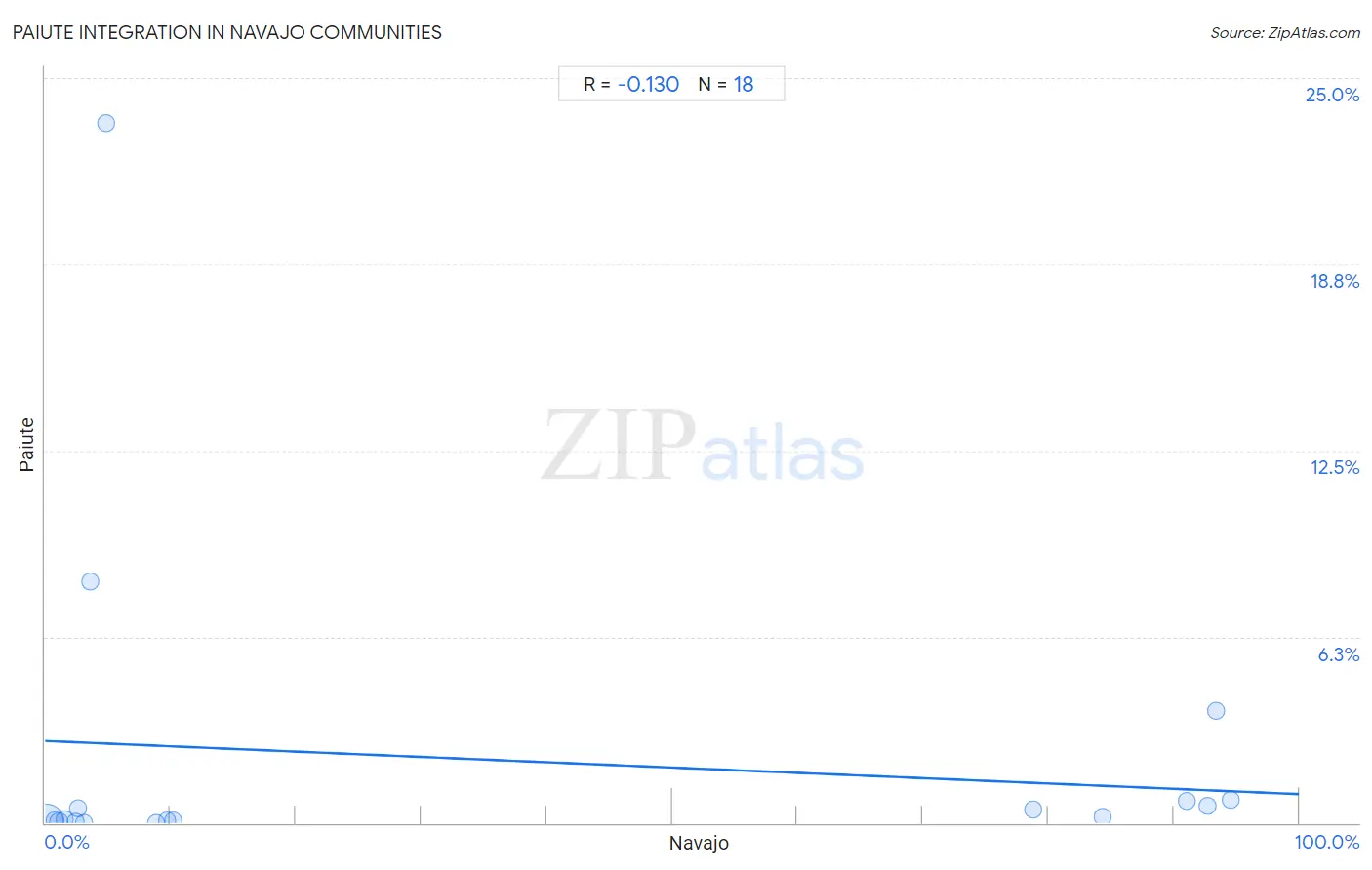
Navajo vs Paiute Income
When considering income, the most significant differences between Navajo and Paiute communities in the United States are seen in per capita income ($29,031 compared to $37,066, a difference of 27.7%), householder income ages 25 - 44 years ($66,529 compared to $82,984, a difference of 24.7%), and median household income ($59,159 compared to $72,959, a difference of 23.3%). Conversely, both communities are more comparable in terms of median female earnings ($33,046 compared to $36,056, a difference of 9.1%), median earnings ($36,999 compared to $41,508, a difference of 12.2%), and householder income over 65 years ($47,722 compared to $53,762, a difference of 12.7%).

| Income Metric | Navajo | Paiute |
| Per Capita Income | Tragic $29,031 | Tragic $37,066 |
| Median Family Income | Tragic $70,989 | Tragic $85,414 |
| Median Household Income | Tragic $59,159 | Tragic $72,959 |
| Median Earnings | Tragic $36,999 | Tragic $41,508 |
| Median Male Earnings | Tragic $42,098 | Tragic $47,991 |
| Median Female Earnings | Tragic $33,046 | Tragic $36,056 |
| Householder Age | Under 25 years | Tragic $42,380 | Fair $51,743 |
| Householder Age | 25 - 44 years | Tragic $66,529 | Tragic $82,984 |
| Householder Age | 45 - 64 years | Tragic $69,759 | Tragic $82,629 |
| Householder Age | Over 65 years | Tragic $47,722 | Tragic $53,762 |
| Wage/Income Gap | Exceptional 22.4% | Good 25.5% |
Navajo vs Paiute Poverty
When considering poverty, the most significant differences between Navajo and Paiute communities in the United States are seen in receiving food stamps (21.1% compared to 14.3%, a difference of 47.6%), family poverty (18.8% compared to 13.0%, a difference of 44.7%), and married-couple family poverty (11.9% compared to 8.3%, a difference of 42.9%). Conversely, both communities are more comparable in terms of single mother poverty (40.2% compared to 35.1%, a difference of 14.4%), female poverty among 25-34 year olds (23.3% compared to 19.6%, a difference of 19.2%), and single female poverty (31.7% compared to 25.5%, a difference of 23.9%).
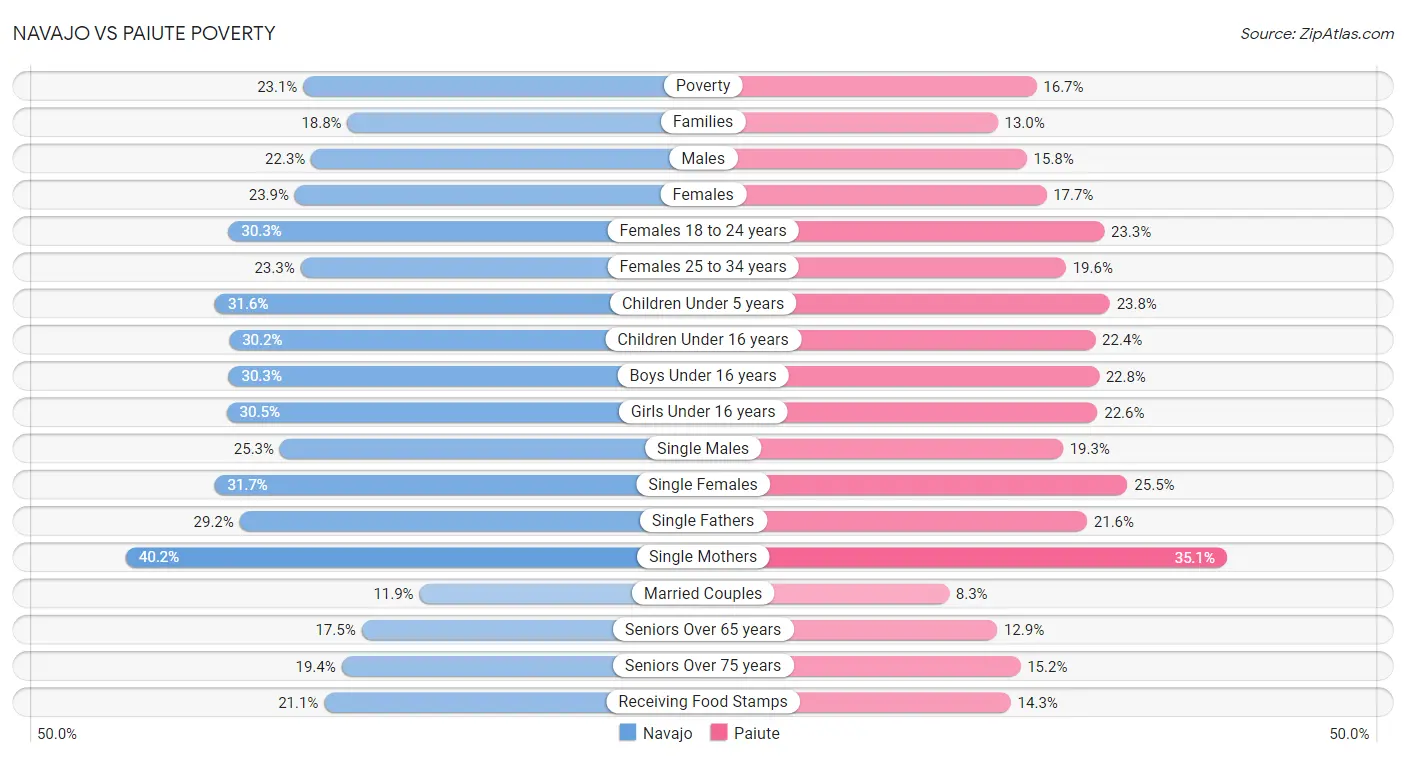
| Poverty Metric | Navajo | Paiute |
| Poverty | Tragic 23.1% | Tragic 16.7% |
| Families | Tragic 18.8% | Tragic 13.0% |
| Males | Tragic 22.3% | Tragic 15.8% |
| Females | Tragic 23.9% | Tragic 17.7% |
| Females 18 to 24 years | Tragic 30.3% | Tragic 23.3% |
| Females 25 to 34 years | Tragic 23.3% | Tragic 19.6% |
| Children Under 5 years | Tragic 31.6% | Tragic 23.8% |
| Children Under 16 years | Tragic 30.2% | Tragic 22.4% |
| Boys Under 16 years | Tragic 30.3% | Tragic 22.8% |
| Girls Under 16 years | Tragic 30.5% | Tragic 22.6% |
| Single Males | Tragic 25.3% | Tragic 19.3% |
| Single Females | Tragic 31.7% | Tragic 25.5% |
| Single Fathers | Tragic 29.2% | Tragic 21.6% |
| Single Mothers | Tragic 40.2% | Tragic 35.1% |
| Married Couples | Tragic 11.9% | Tragic 8.3% |
| Seniors Over 65 years | Tragic 17.5% | Tragic 12.9% |
| Seniors Over 75 years | Tragic 19.4% | Tragic 15.2% |
| Receiving Food Stamps | Tragic 21.1% | Tragic 14.3% |
Navajo vs Paiute Unemployment
When considering unemployment, the most significant differences between Navajo and Paiute communities in the United States are seen in unemployment among women with children ages 6 to 17 years (14.2% compared to 8.5%, a difference of 66.5%), unemployment among ages 25 to 29 years (12.2% compared to 7.4%, a difference of 64.3%), and unemployment among ages 30 to 34 years (10.6% compared to 6.7%, a difference of 57.5%). Conversely, both communities are more comparable in terms of unemployment among ages 55 to 59 years (6.7% compared to 6.8%, a difference of 0.52%), unemployment among seniors over 75 years (9.1% compared to 8.6%, a difference of 5.9%), and unemployment among seniors over 65 years (6.7% compared to 6.3%, a difference of 5.9%).
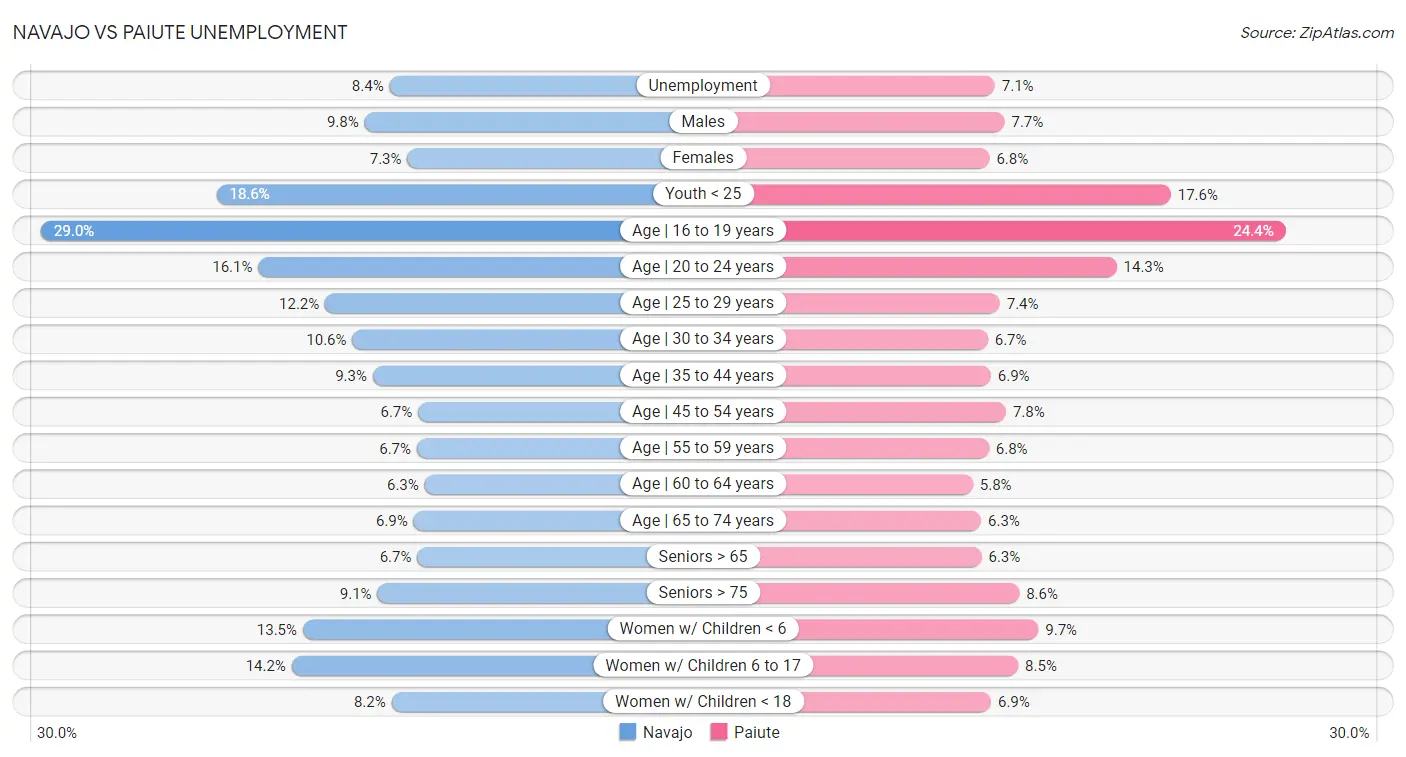
| Unemployment Metric | Navajo | Paiute |
| Unemployment | Tragic 8.4% | Tragic 7.1% |
| Males | Tragic 9.8% | Tragic 7.7% |
| Females | Tragic 7.3% | Tragic 6.8% |
| Youth < 25 | Tragic 18.6% | Tragic 17.6% |
| Age | 16 to 19 years | Tragic 29.0% | Tragic 24.4% |
| Age | 20 to 24 years | Tragic 16.1% | Tragic 14.3% |
| Age | 25 to 29 years | Tragic 12.2% | Tragic 7.4% |
| Age | 30 to 34 years | Tragic 10.6% | Tragic 6.7% |
| Age | 35 to 44 years | Tragic 9.3% | Tragic 6.9% |
| Age | 45 to 54 years | Tragic 6.7% | Tragic 7.8% |
| Age | 55 to 59 years | Tragic 6.7% | Tragic 6.8% |
| Age | 60 to 64 years | Tragic 6.3% | Tragic 5.8% |
| Age | 65 to 74 years | Tragic 6.9% | Tragic 6.3% |
| Seniors > 65 | Tragic 6.7% | Tragic 6.3% |
| Seniors > 75 | Tragic 9.1% | Excellent 8.6% |
| Women w/ Children < 6 | Tragic 13.5% | Tragic 9.7% |
| Women w/ Children 6 to 17 | Tragic 14.2% | Exceptional 8.5% |
| Women w/ Children < 18 | Tragic 8.2% | Tragic 6.9% |
Navajo vs Paiute Labor Participation
When considering labor participation, the most significant differences between Navajo and Paiute communities in the United States are seen in in labor force | age 16-19 (32.1% compared to 37.5%, a difference of 17.0%), in labor force | age 20-24 (64.8% compared to 75.3%, a difference of 16.2%), and in labor force | age 30-34 (73.8% compared to 81.2%, a difference of 10.1%). Conversely, both communities are more comparable in terms of in labor force | age 25-29 (74.6% compared to 78.1%, a difference of 4.6%), in labor force | age 45-54 (72.8% compared to 76.7%, a difference of 5.3%), and in labor force | age > 16 (56.6% compared to 60.7%, a difference of 7.3%).

| Labor Participation Metric | Navajo | Paiute |
| In Labor Force | Age > 16 | Tragic 56.6% | Tragic 60.7% |
| In Labor Force | Age 20-64 | Tragic 69.2% | Tragic 74.7% |
| In Labor Force | Age 16-19 | Tragic 32.1% | Excellent 37.5% |
| In Labor Force | Age 20-24 | Tragic 64.8% | Good 75.3% |
| In Labor Force | Age 25-29 | Tragic 74.6% | Tragic 78.1% |
| In Labor Force | Age 30-34 | Tragic 73.8% | Tragic 81.2% |
| In Labor Force | Age 35-44 | Tragic 73.8% | Tragic 80.6% |
| In Labor Force | Age 45-54 | Tragic 72.8% | Tragic 76.7% |
Navajo vs Paiute Family Structure
When considering family structure, the most significant differences between Navajo and Paiute communities in the United States are seen in single mother households (8.8% compared to 7.0%, a difference of 27.2%), births to unmarried women (51.5% compared to 42.5%, a difference of 21.3%), and divorced or separated (12.0% compared to 13.6%, a difference of 13.5%). Conversely, both communities are more comparable in terms of family households with children (26.9% compared to 26.4%, a difference of 2.2%), single father households (3.2% compared to 3.3%, a difference of 3.4%), and family households (66.4% compared to 64.0%, a difference of 3.7%).

| Family Structure Metric | Navajo | Paiute |
| Family Households | Exceptional 66.4% | Fair 64.0% |
| Family Households with Children | Tragic 26.9% | Tragic 26.4% |
| Married-couple Households | Tragic 40.1% | Tragic 42.1% |
| Average Family Size | Exceptional 3.65 | Exceptional 3.29 |
| Single Father Households | Tragic 3.2% | Tragic 3.3% |
| Single Mother Households | Tragic 8.8% | Tragic 7.0% |
| Currently Married | Tragic 39.0% | Tragic 42.7% |
| Divorced or Separated | Good 12.0% | Tragic 13.6% |
| Births to Unmarried Women | Tragic 51.5% | Tragic 42.5% |
Navajo vs Paiute Vehicle Availability
When considering vehicle availability, the most significant differences between Navajo and Paiute communities in the United States are seen in no vehicles in household (9.4% compared to 11.8%, a difference of 25.4%), 4 or more vehicles in household (8.2% compared to 9.0%, a difference of 9.6%), and 3 or more vehicles in household (22.3% compared to 23.8%, a difference of 6.7%). Conversely, both communities are more comparable in terms of 2 or more vehicles in household (55.3% compared to 55.8%, a difference of 0.75%), 1 or more vehicles in household (90.8% compared to 88.6%, a difference of 2.4%), and 3 or more vehicles in household (22.3% compared to 23.8%, a difference of 6.7%).

| Vehicle Availability Metric | Navajo | Paiute |
| No Vehicles Available | Exceptional 9.4% | Tragic 11.8% |
| 1+ Vehicles Available | Exceptional 90.8% | Tragic 88.6% |
| 2+ Vehicles Available | Average 55.3% | Good 55.8% |
| 3+ Vehicles Available | Exceptional 22.3% | Exceptional 23.8% |
| 4+ Vehicles Available | Exceptional 8.2% | Exceptional 9.0% |
Navajo vs Paiute Education Level
When considering education level, the most significant differences between Navajo and Paiute communities in the United States are seen in professional degree (2.9% compared to 3.4%, a difference of 20.0%), bachelor's degree (23.6% compared to 28.1%, a difference of 19.0%), and associate's degree (32.6% compared to 36.4%, a difference of 11.6%). Conversely, both communities are more comparable in terms of 6th grade (96.8% compared to 96.8%, a difference of 0.010%), nursery school (98.0% compared to 98.0%, a difference of 0.020%), and kindergarten (98.0% compared to 97.9%, a difference of 0.060%).
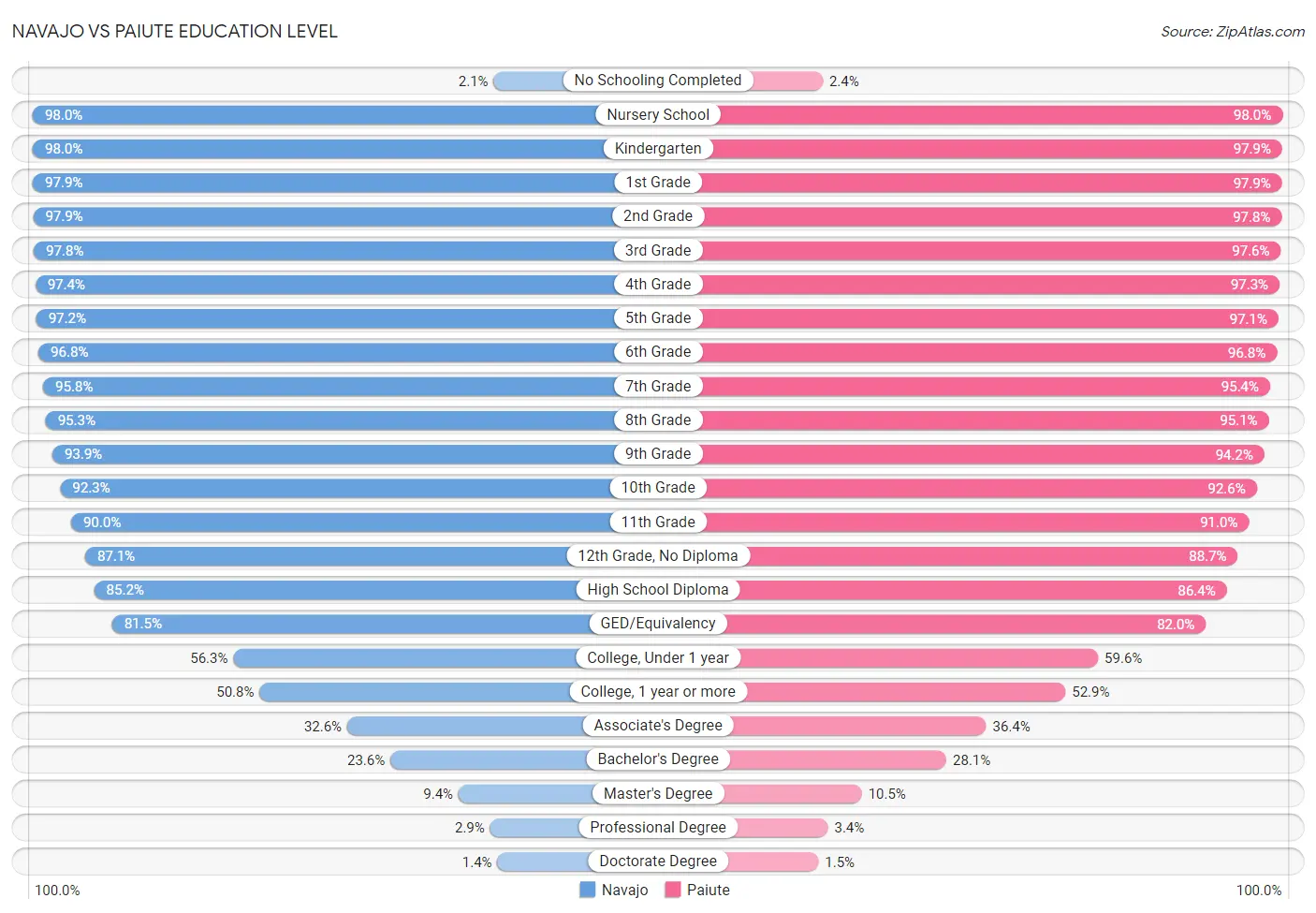
| Education Level Metric | Navajo | Paiute |
| No Schooling Completed | Fair 2.1% | Tragic 2.4% |
| Nursery School | Average 98.0% | Average 98.0% |
| Kindergarten | Average 98.0% | Fair 97.9% |
| 1st Grade | Average 97.9% | Fair 97.9% |
| 2nd Grade | Average 97.9% | Fair 97.8% |
| 3rd Grade | Average 97.8% | Poor 97.6% |
| 4th Grade | Fair 97.4% | Poor 97.3% |
| 5th Grade | Fair 97.2% | Poor 97.1% |
| 6th Grade | Tragic 96.8% | Tragic 96.8% |
| 7th Grade | Poor 95.8% | Tragic 95.4% |
| 8th Grade | Tragic 95.3% | Tragic 95.1% |
| 9th Grade | Tragic 93.9% | Tragic 94.2% |
| 10th Grade | Tragic 92.3% | Tragic 92.6% |
| 11th Grade | Tragic 90.0% | Tragic 91.0% |
| 12th Grade, No Diploma | Tragic 87.1% | Tragic 88.7% |
| High School Diploma | Tragic 85.2% | Tragic 86.4% |
| GED/Equivalency | Tragic 81.5% | Tragic 82.0% |
| College, Under 1 year | Tragic 56.3% | Tragic 59.6% |
| College, 1 year or more | Tragic 50.8% | Tragic 52.9% |
| Associate's Degree | Tragic 32.6% | Tragic 36.4% |
| Bachelor's Degree | Tragic 23.6% | Tragic 28.1% |
| Master's Degree | Tragic 9.4% | Tragic 10.5% |
| Professional Degree | Tragic 2.9% | Tragic 3.4% |
| Doctorate Degree | Tragic 1.4% | Tragic 1.5% |
Navajo vs Paiute Disability
When considering disability, the most significant differences between Navajo and Paiute communities in the United States are seen in disability age under 5 (1.6% compared to 3.9%, a difference of 137.0%), disability age 65 to 74 (33.3% compared to 27.8%, a difference of 19.9%), and hearing disability (4.6% compared to 4.1%, a difference of 13.7%). Conversely, both communities are more comparable in terms of female disability (14.2% compared to 14.0%, a difference of 1.1%), self-care disability (2.9% compared to 2.9%, a difference of 2.0%), and ambulatory disability (7.5% compared to 7.7%, a difference of 2.4%).
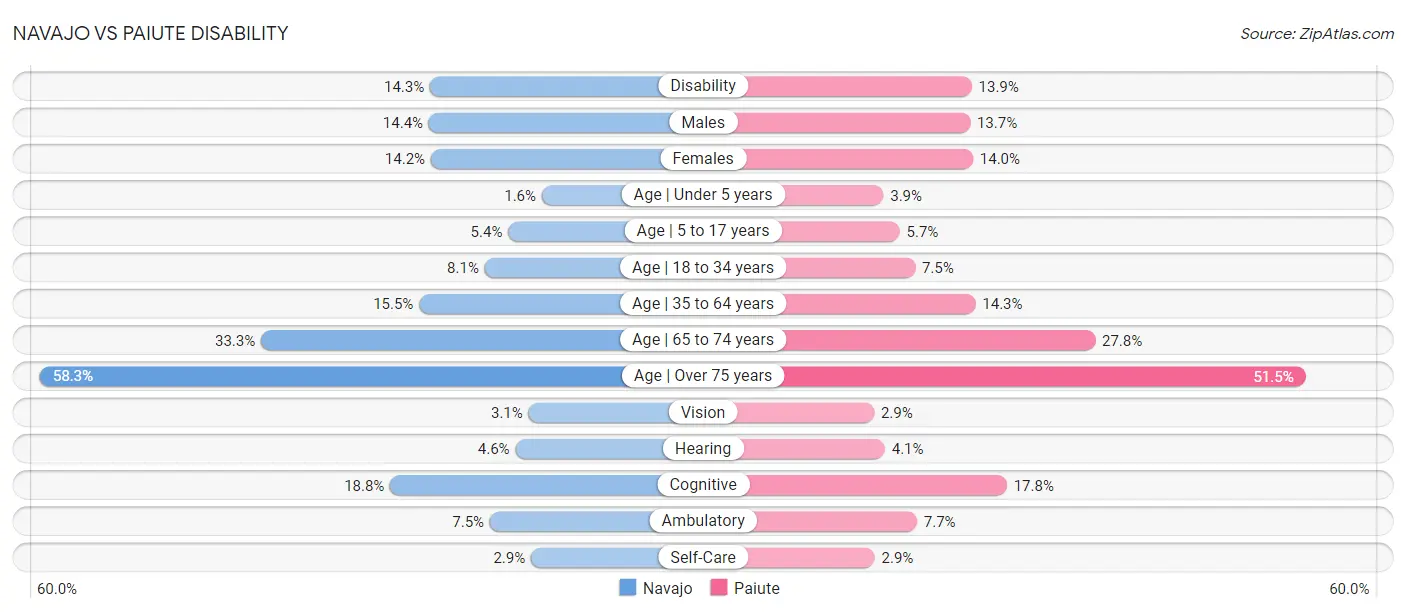
| Disability Metric | Navajo | Paiute |
| Disability | Tragic 14.3% | Tragic 13.9% |
| Males | Tragic 14.4% | Tragic 13.7% |
| Females | Tragic 14.2% | Tragic 14.0% |
| Age | Under 5 years | Tragic 1.6% | Tragic 3.9% |
| Age | 5 to 17 years | Exceptional 5.4% | Poor 5.7% |
| Age | 18 to 34 years | Tragic 8.1% | Tragic 7.5% |
| Age | 35 to 64 years | Tragic 15.5% | Tragic 14.3% |
| Age | 65 to 74 years | Tragic 33.3% | Tragic 27.8% |
| Age | Over 75 years | Tragic 58.3% | Tragic 51.5% |
| Vision | Tragic 3.1% | Tragic 2.9% |
| Hearing | Tragic 4.6% | Tragic 4.1% |
| Cognitive | Tragic 18.8% | Tragic 17.8% |
| Ambulatory | Tragic 7.5% | Tragic 7.7% |
| Self-Care | Tragic 2.9% | Tragic 2.9% |